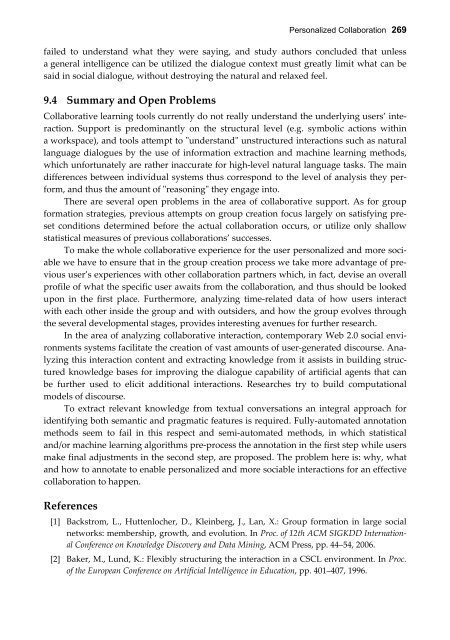elektronická verzia publikácie - FIIT STU - Slovenská technická ...
elektronická verzia publikácie - FIIT STU - Slovenská technická ...
elektronická verzia publikácie - FIIT STU - Slovenská technická ...
You also want an ePaper? Increase the reach of your titles
YUMPU automatically turns print PDFs into web optimized ePapers that Google loves.
Personalized Collaboration 269<br />
failed to understand what they were saying, and study authors concluded that unless<br />
a general intelligence can be utilized the dialogue context must greatly limit what can be<br />
said in social dialogue, without destroying the natural and relaxed feel.<br />
9.4 Summary and Open Problems<br />
Collaborative learning tools currently do not really understand the underlying users’ interaction.<br />
Support is predominantly on the structural level (e.g. symbolic actions within<br />
a workspace), and tools attempt to "understand" unstructured interactions such as natural<br />
language dialogues by the use of information extraction and machine learning methods,<br />
which unfortunately are rather inaccurate for high-level natural language tasks. The main<br />
differences between individual systems thus correspond to the level of analysis they perform,<br />
and thus the amount of "reasoning" they engage into.<br />
There are several open problems in the area of collaborative support. As for group<br />
formation strategies, previous attempts on group creation focus largely on satisfying preset<br />
conditions determined before the actual collaboration occurs, or utilize only shallow<br />
statistical measures of previous collaborations’ successes.<br />
To make the whole collaborative experience for the user personalized and more sociable<br />
we have to ensure that in the group creation process we take more advantage of previous<br />
user’s experiences with other collaboration partners which, in fact, devise an overall<br />
profile of what the specific user awaits from the collaboration, and thus should be looked<br />
upon in the first place. Furthermore, analyzing time-related data of how users interact<br />
with each other inside the group and with outsiders, and how the group evolves through<br />
the several developmental stages, provides interesting avenues for further research.<br />
In the area of analyzing collaborative interaction, contemporary Web 2.0 social environments<br />
systems facilitate the creation of vast amounts of user-generated discourse. Analyzing<br />
this interaction content and extracting knowledge from it assists in building structured<br />
knowledge bases for improving the dialogue capability of artificial agents that can<br />
be further used to elicit additional interactions. Researches try to build computational<br />
models of discourse.<br />
To extract relevant knowledge from textual conversations an integral approach for<br />
identifying both semantic and pragmatic features is required. Fully-automated annotation<br />
methods seem to fail in this respect and semi-automated methods, in which statistical<br />
and/or machine learning algorithms pre-process the annotation in the first step while users<br />
make final adjustments in the second step, are proposed. The problem here is: why, what<br />
and how to annotate to enable personalized and more sociable interactions for an effective<br />
collaboration to happen.<br />
References<br />
[1] Backstrom, L., Huttenlocher, D., Kleinberg, J., Lan, X.: Group formation in large social<br />
networks: membership, growth, and evolution. In Proc. of 12th ACM SIGKDD International<br />
Conference on Knowledge Discovery and Data Mining, ACM Press, pp. 44–54, 2006.<br />
[2] Baker, M., Lund, K.: Flexibly structuring the interaction in a CSCL environment. In Proc.<br />
of the European Conference on Artificial Intelligence in Education, pp. 401–407, 1996.

















